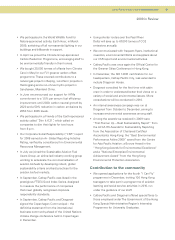Cathay Pacific 2009 Annual Report Download - page 21
Download and view the complete annual report
Please find page 21 of the 2009 Cathay Pacific annual report below. You can navigate through the pages in the report by either clicking on the pages listed below, or by using the keyword search tool below to find specific information within the annual report.
Review of Operations PASSENGER SERVICES
Home market – Hong Kong and
Pearl River Delta
Our home market was deeply affected by the
economic downturn, particularly by its effect on
passenger demand for premium seats. Our front-end
business out of Hong Kong is heavily dependent on
financial institutions, most of which were hit hard by
the financial crisis.
Corporate sales were affected by companies either
cutting back on travel by employees or downgrading
from premium to economy class travel. There was
some minor reassessment later in the year but at
the end of 2009 many companies still had travel
restrictions in place.
Demand in our economy cabins remained strong
throughout the year. However, aggressive fare
promotions were required to stimulate this demand in
a very competitive market. This depressed yields.
The outbreak of the Influenza A (H1N1) virus had
a significant impact on business during May,
June and July, in particular affecting leisure travel
and group business between Hong Kong and
regional destinations.
Dragonair’s business derived from the Pearl River
Delta region increased following the launch of a twice
daily service between Hong Kong and Guangzhou in
September. The service has proved popular with
travellers who have Hong Kong connecting flights.
Comments by region are as follows:
Southwest Pacific and South Africa
Demand and yield suffered as a result of the
economic downturn. Premium traffic in particular
was badly hit. Economy class loads held up well on
most routes although this was only achieved at the
expense of yield due to very significant competition
for business. In response to the economic downturn,
we reduced capacity on some services. Frequencies
on the Sydney route were reduced from four flights a
day to three and we withdrew three non-stop
services to Brisbane.
We introduced seasonal increases to the number of
frequencies on the Auckland route from late October,
when twice daily services were introduced to cater
for the southern summer demand.
•
•
•
•
•
•
•
The South African route enjoyed a better year than
most other routes. The load factor was high
throughout the year and yield reductions were less
severe than elsewhere, though there was a marked
slowdown in the winter as usual.
Europe
We reduced frequencies on the Frankfurt, London and
Paris routes in response to the economic downturn.
The reduction in premium traffic was particularly
significant on the European routes in the first three
quarters of the year, with big reductions in both
passenger numbers and yield.
Europe was the first region to show tentative signs of
a slow recovery, as demand for premium seats began
to recover during the last quarter of the year,
particularly on the London route. However, yields
were still well below normal peak-season levels and
the improvement was from a very low base.
Economy class demand remained fairly robust on all
European routes throughout the year, although to
achieve this yields fell sharply, with aggressive
competition in all markets.
In December we announced a strengthening of our
European network with the launch of a new four
times weekly service to Milan, commencing in March
2010. This will supplement the current daily service to
Rome. We have also announced plans to begin a
thrice-weekly service to Moscow from summer 2010.
North Asia
Our passenger business to and from Mainland China
was generally slow during the year, although there
was some recovery in the fourth quarter, but at
reduced yields. Demand for premium seats remained
weak, as companies continued to operate under
highly restrictive travel policies.
We reduced Dragonair services to Sanya to help
balance capacity with demand. We also suspended
services to Dalian, Fukuoka, Guilin, Shenyang,
Taichung and Xian from May.
Business to and from Japan was adversely affected
by currency movements and by the economic
downturn. In addition, Influenza A (H1N1) caused a
substantial reduction in bookings from May to July.
•
•
•
•
•
•
•
•
•
Cathay Pacific Airways Limited Annual Report 2009 19
























